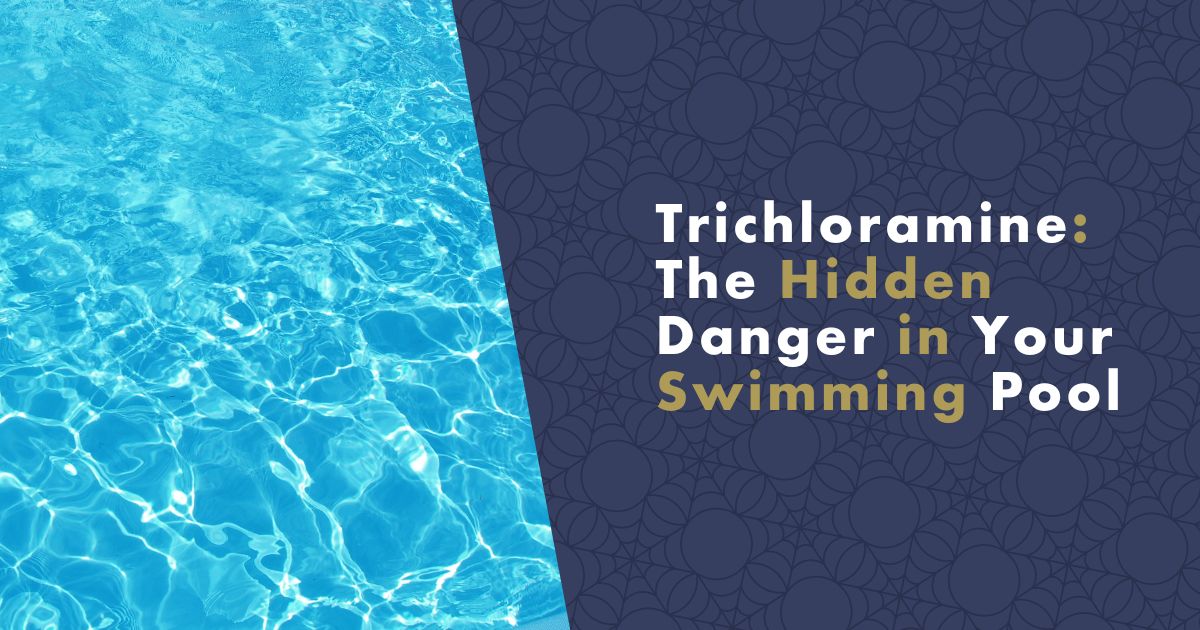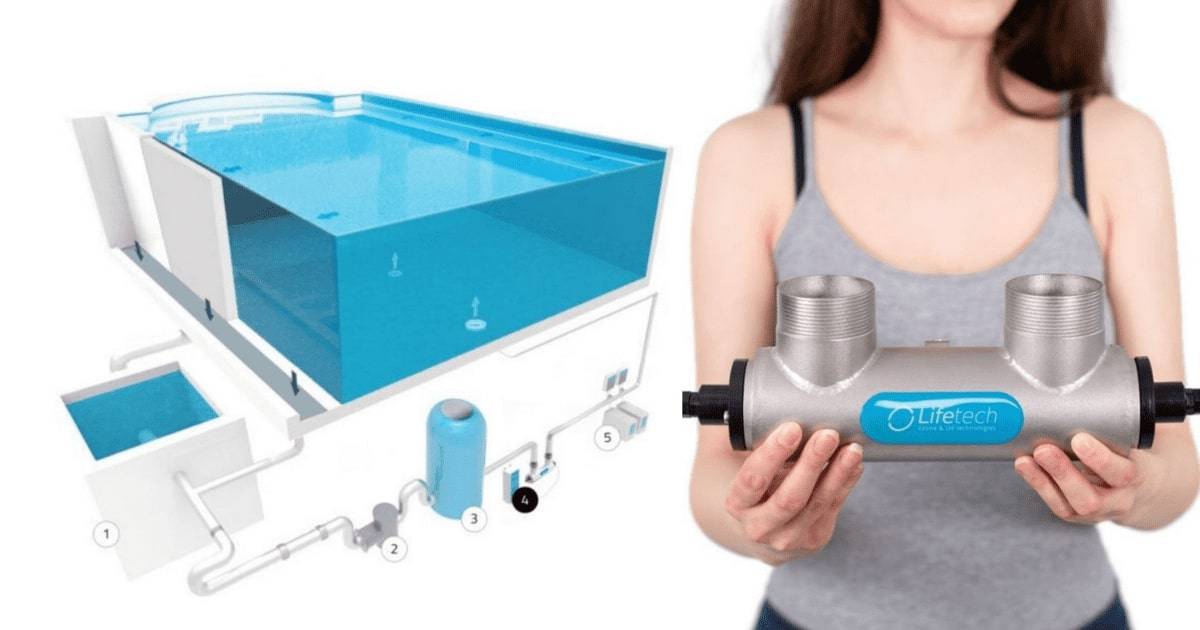You probably know the smell of chlorine in indoor pools quite well. Subconsciously, you perceive it as the necessary "scent of cleanliness," but in reality, it's a bit different. The pungent odor is caused by the health-hazardous trichloramine, which forms in pools and hot tubs through chemical reactions involving chlorine.

It's because of trichloramine that you may have irritated eyes, cough, difficulty breathing, and other health issues when in the pool.
It's a paradox. Chlorine is commonly used to disinfect water so you can enjoy a pleasant time in pools and hot tubs without unwanted bacteria, algae, and disease-causing pathogens. Chlorine-based pool chemistry is supposed to ensure clean and healthy swimming.
Reality isn't so rosy, though. While chlorine works as a relatively reliable disinfectant, it is also associated with the formation of toxic chemicals. The reaction of chlorine with impurities in the water generates hundreds of chemicals. Experts have shown through studies that some of these compounds can be harmful to health and, in critical concentrations, even carcinogenic.
An eco-friendly water maintenance solution based on nanotechnology can be found in our nanoSPACE eshop.
Basic Information about Trichloramine
Trichloramine is considered the chlorine compound with the worst impact on human health. You may also know it by names like nitrogen trichloride, trichloroammonia, or chloramine. Its chemical formula is NCl3. Trichloramine forms through the reaction of chlorine with impurities in the water.
You might feel relieved now. Before entering the pool, you always thoroughly rinse off in the shower, so trichloramine shouldn't be a problem for you.
Unfortunately, that's not the case. Showering gets rid of larger impurities, but experts state that every person carries up to 2.5 billion microorganisms into the water. And it doesn't stop there. During swimming, the water releases micro-particles of skin, hair, sweat, sebaceous and mucous secretions, fungi, yeast, residues of cosmetic products, and sunscreen creams.
One "advantage" of toxic trichloramine is its unmistakable smell. If you sense that typical pool odor, you can be 100% sure that you have a trichloramine problem.
Trichloramine and Health Risks
Health risks should not be taken lightly. There are scientific studies that warn that people spending a lot of time near pools (such as lifeguards and professional swimmers) face many more respiratory problems compared to the general population.
Similarly, the National Institute of Public Health warns that long-term exposure to trichloramine is a proven risk factor for asthma and allergies. Some foreign sources even state that asthma has been recognized as an occupational disease for pool staff.
Be cautious of short-term exposure to trichloramine as well. Common health problems caused by trichloramine include:
- Acute eye irritation
- Cough and difficulty breathing
- Irritation and damage to the epithelium of the upper respiratory tract
- Contribution to the development of asthma and allergies
- Allergic reactions in sensitive individuals
- Skin irritation and drying
The potential health risks are amplified by the fact that the highest concentration of trichloramine is often right above the water surface. So, you literally have this toxic substance in aerosol form right under your nose while swimming and having fun, inevitably getting it into your body.
Why Wasn't Trichloramine Talked about?
If you don't treat the water in your pool, hot tub, or garden pond, it will turn from crystal clear to disgustingly green in a matter of days. The quality of water deteriorates rapidly, especially during hot summer months. Public swimming pools and facilities must also adhere to hygiene standards. It's for these reasons that water treatment is simply necessary.

The side effects of water disinfection were understood to some extent, but until recently, there was no better alternative. That's why trichloramine wasn't talked about much. It was simply a necessary evil that prevented even greater harm.
Today, times have changed. Relatively recently, technology has changed with UV medium-pressure lamps, transforming the situation in public swimming facilities. Now, you can easily install this healthy purification method in your private pool as well. Finally, you can have perfectly clean water without harmful substances.
TIP: Low-Pressure vs. Medium-Pressure UV Systems: A Comparative Analysis
It Can Destroy Steel Structures
Trichloramine doesn't only affect the human body. It also contributes to the corrosion of metal structures in indoor pool facilities. If the negative impact is underestimated, accidents can occur. You might think we're exaggerating, but unfortunately, we're not.
Just look at history. In 1985, in the Swiss town of Uster, 12 people died due to the collapse of a corrosion-weakened structure in a pool hall.
Generally, there is a higher risk in enclosed and poorly ventilated spaces because trichloramine can concentrate more in them. It's worth mentioning that hot tubs can have up to three times more trichloramine than pools intended for infants.
If a compound can corrode stainless steel, it's probably not a good idea to voluntarily inhale it. You don't need to be a chemist to figure that out; common sense is enough.
How to Get Rid of Trichloramine in Pools?
In conclusion, it's important to set the record straight. Trichloramine, which is harmful to health, will always form in pool water. Even in pools with saltwater or seawater, chlorine is formed through the electrolysis of dissolved salt (NaCl), and then, through reactions with impurities, trichloramine is created.
Until recently, getting rid of this toxic substance was a real challenge. While trichloramine concentration could be reduced with water filtration using reverse osmosis, it was highly inefficient and costly. Similarly, using carbon adsorption to remove the toxic component wasn't very cost-effective.
That's why the health effects of trichloramine on human health were largely ignored for a long time. But now, you don't have to risk health problems anymore. Medium-pressure UVM systems can not only disinfect water but also break down various toxic substances, including the dreaded trichloramine. Water treated this way is suitable even for individuals with sensitive skin and toddlers.
Tip: Read Beware of "Unknown" Health Risks in Pools. We Know How to Deal with Them.
#produkty#https://www.nanospace.store/search/?string=UVM
Sources and References
- SZÚ Recommendations for Monitoring Trichloramine in Pools
- Trichloramine in the Air of Swimming Pools, National Institute of Public Health in Plzeň
- Trichloramine in the Air of Swimming Pools
- Possible Toxicity of Algae and Their Potential Impact on the Health of Animals and Humans
- Trichloramine and Infant Swimming from the Perspective of a Control Laboratory
- Reducing Trichloramine in Pool Water
- Exposure to Trichloramine and Respiratory Symptoms in Indoor Swimming Pool Workers
- Dangerous Gas in Chlorinated Pools: Risk Increases in Winter, Asthma Is a Threat

